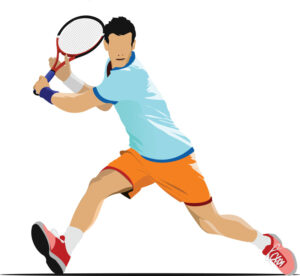
© Can Stock Photo / leonido
Homeopathy can help with joint and muscle pain. With early intervention may save the surgeon’s knife. Now, there is no denying the wonders of modern surgery and hip-joint replacement. This seems to have become almost a right of passage when you get to my sort of age. Moreover, these days patients are in and out or hospital quicker than a tyre change by a Kwik-fit Fitter.

Interestingly, in the not too distant past, surgeons where rather the second class citizens of the medical world. Often the last resort.
Should your barber or hairdresser’s premises sport a red and white striped pole, this harks back to the days of the barber-surgeons who would undertake certain surgical procedures as well a giving a ‘short back and sides’.
A Trade Guild was established in 1540 (the livery company exists to this day), but by 1800 the two organisations were split and the Royal College of Surgeons established.
However, what fascinates is when friends tell me that their hip or knee has ‘worn out’. It is Man the Machine. There is of course a certain truth in this, the X-ray or scan doesn’t lie. However, as I pointed out in an earlier blog the cells in our bodies are in a continual state of death and renewal. Apparently some 10 million cells die and are replaced every second. Indeed, I recently read that if you see someone you know after six months or so, not one cell of their face remains from the last time that your paths crossed!
Now if you think about it, the real problem is not wear and tear, apparent as that may be. Rather it is the regeneration ability that has diminished. Clearly the ageing process is a key factor, unless you happen to be the athletic sort in which case aggressive wear and tear might outstrip the ability to repair. As we enter the Wimbledon tennis season, I find it very interesting to compare the likes of Federer and Djokovic with Nadal and our own Andy Murray, the former two having suffered less on the injury front.
The real question is how we might best preserve the underlying capacity of the body to repair and maintain itself.
Dr Samuel Hahnemann of whom I spoke last month, wrote in his Organon of Medicine:
“In the state of health the spirit-like vital force (dynamis) animating the material human organism reigns in supreme sovereignty. It maintains the sensation and activities of all parts of the living organism in a harmony that obliges wonderment. The reasoning spirit who inhabit the organism can thus freely use this healthy living instrument to reach the lofty goal of human existence”
“Without the vital force* the material organism is unable to feel, or act, OR MAINTAIN ITSELF. Only because of the immaterial being (vital principle) that animates it in health and in disease can it feel and maintain its vital functions.
(* Without the vital force the body dies; and then delivered exclusively to the forces of the outer material world, it decomposes, reverting to its chemical constituents.)
“…it is only this vital force thus untuned which brings about in the organism the disagreeable sensations and abnormal functions that we call disease”
Dr Samual Hahnemann, Organon of Medicine 6th Edition, Translated by Künzli et al, Gollanz 1989
Quite simply he is saying that we are animated by an immaterial source of dynamic energy which preserves our health, and if this energy supply is disturbed then disharmony and disease will result.
Logically then it is of great importance to the balance of the body that this flow of energy is maintained. The longevity of our joints depends upon the harmonious existence between the immaterial life principle (vital force) and material (physical) body.
The vital force is central to homeopathic philosophy, a principle that sits well with the philosophies of acupuncture, osteopathy and other systems of medicine (Chinese, Indian etc). Although the precise mechanisms remain obscure it is increasingly clear that potentised homeopathic remedies interact energetically (or informationally) in some manner that restores harmony to the living organism (read again the first paragraph from the Organon of Medicine, above).
Homeopathy may not seem to be an obvious therapy for musculoskeletal injury but there are a range of remedies well suited to such as hip joint disease. Here below are but a few examples with brief characteristics. The task for the homeopath is to match the symptoms of the patient to the characteristics of the remedy. Homeopathy is the application of the natural law of similars – like cures like.
As you proceed down the list that follows, you move from the more acute (short term) to the more chronic (deep seated).
Homeopathy is unlikely to restore established pathology, and as the old saying goes “a stitch in time saves nine”.
Colocynthis – cannot stand / sit, worse for motion, neuralgia and spasm, better for pressure, right sided
Rhus Tox – classically pain on first movement, then eases, better for warmth
Phytolacca – shooting pain like electric shock, swollen hot joints, inflamed periosteum
Pulsatilla – shifting pains, sense of dislocation, worse for warmth in any form
Natrum Sulph – pain extends to knees, better for walking and cold application, worse for damp
Causticum – pain as if dislocated, worse on first motion and lying on hip, extends down or up